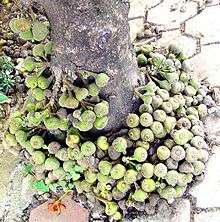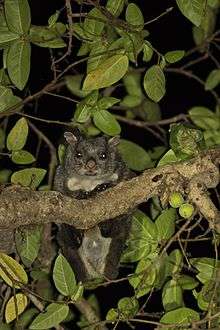Ficus racemosa
| Ficus racemosa | |
|---|---|
| Scientific classification | |
| Kingdom: | Plantae |
| Clade: | Angiosperms |
| Clade: | Eudicots |
| Clade: | Rosids |
| Order: | Rosales |
| Family: | Moraceae |
| Genus: | Ficus |
| Species: | F. racemosa |
| Binomial name | |
| Ficus racemosa | |
| Synonyms | |
|
Ficus glomerata Roxb. | |
Ficus racemosa (syn. Ficus glomerata Roxb.) is a species of plant in the family Moraceae. Popularly known as the cluster fig tree, Indian fig tree or goolar (gular) fig, this is native to Australia, Malesia, Indo-China and the Indian subcontinent. It is unusual in that its figs grow on or close to the tree trunk, termed cauliflory. In India, the tree and its fruit are called gular in the north and atti in the south. The fruits are a favourite staple of the common Indian macaque. It serves as a food plant for the caterpillars of the two-brand crow butterfly (Euploea sylvester) of northern Australia.[1]
In Hinduism
In the Atharva Veda, this fig tree (Sanskrit: uḍumbara or udumbara)[2] is given prominence as a means for acquiring prosperity and vanquishing foes.[3] For instance, regarding an amulet of the udumbara tree, a hymn (AV xix,31) extols:
- The Lord of amulets art thou, most mighty: in thee wealth's
- ruler hath engendered riches,
- These gains are lodged in thee, and all great treasures. Amulet,
- conquer thou: far from us banish malignity and indigence,
- and hunger.
- Vigour art thou, in me do thou plant vigour: riches art thou, so
- do thou grant me riches.
- Plenty art thou, so prosper me with plenty: House-holder, hear
- a householder's petition.[4]
It has been described in the story of Raja Harischandra of the Ikshvaku dynasty, that the crown was a branch of this udumbura tree, set in a circlet of gold. Additionally, the throne (simhasana) was constructed out of this wood and the royal personage would ascend it on his knee, chanting to the gods to ascend it with him, which they did so, albeit unseen. Its leaves are an indispensable part of many Hindu havans.
In Buddhism

Both the tree and the flower are referred to as the udumbara (Sanskrit, Pali; Devanagari: उडुम्बर) in Buddhism.[5] Udumbara can also refer to the blue lotus (nila-udumbara, "blue udumbara") flower. The udumbara flower appears in chapters 2 and 27 of the Lotus Sutra, an important Mahayana Buddhist text. The Japanese word udon-ge (優曇華, literally "udon/udumbara flower") was used by Dōgen Zenji to refer to the flower of the udumbara tree in chapter 68 of the Shōbōgenzō ("Treasury of the Eye of the True Dharma"). Dōgen places the udonge in the context of the Flower Sermon given by Gautama Buddha on Vulture Peak. Udonge is also used to refer to the eggs of the lacewing insect. The eggs are laid in a pattern similar to a flower, and its shape is used for divination in Asian fortune telling.[6]
In Theravada Buddhism, the plant is said to have used as the tree for achieved enlightenment (bodhi) by the 26th Lord Buddha, Konaagama (Sinhalese: කෝණාගම).
Uses


The Ovambo people call the fruit of the cluster fig eenghwiyu and use it to distill ombike, their traditional liquor.[7]
Health uses
The bark of audumbar (oudumbar) tree is said to have healing power. In countries like India, the bark is rubbed on a stone with water to make a paste, which can be applied over afflicted by boils or mosquito bites. Allow the paste to dry on the skin and reapply after a few hours. For people whose skin is especially sensitive to insect bites, this is a very simple home remedy.
International naming
- ਗੂਲਰ (guular) in Punjabi
- गूलर (guular) in Hindi
- ಅತ್ತಿ (atti) in Kannada
- ઉમરાં (umaraa) in Gujarati
- যজ্ঞ ডিমৰু (jagna dimaru) in Assamese
- ଡିମ୍ବିରି (dimbiri) in Oriya/Odiya
- අටිටිකිකා (attikka) in Sinhala
- మేడి పండు (medi pandu) Telugu
- மலையின் முனிவன் (malaiyin munivan) in Tamil
- அத்தி (aththi) Tamil
- അത്തി (aththi) Malayalam.
- उंबर (umbar) / औदुंबर (audumbar) in Marathi.
- যজ্ঞডুমুর, জগডুমুর (jogdumur) in Bengali
- डुम्री (dumri) in Nepal
- loa in Sundanese and Indonesian
- elo in Javanese
- Na'a in Bimanese Indonesian
- มะเดื่ออุทุมพร (ma-duer uthumphon) / มะเดื่อชุมพร (ma-duer chumphon) in Thai
- sung (/ʃuŋ/ or /suŋ/) in Vietnamese
- သဖန်း (/ʃuŋ/ or /suŋ/) in Myanmar
References
- ↑ Braby, Michael F. (2005). The Complete Field Guide to Butterflies of Australia. Collingwood, Victoria: CSIRO Publishing. p. 194. ISBN 0-643-09027-4.
- ↑ Monier-Williams, Monier (1899, 1964). A Sanskrit-English Dictionary (London: Oxford University Press), pp. 175, 186. Retrieved 19 Nov 2008 from "Cologne University" at http://www.sanskrit-lexicon.uni-koeln.de/scans/MWScan/MWScanpdf/mw0175-ujjha.pdf and http://www.sanskrit-lexicon.uni-koeln.de/scans/MWScan/MWScanpdf/mw0186-udaya.pdf.
- ↑ See, e.g., Shyam Singh Shashi (1999), Encyclopaedia Indica (Anmol Publications), Ch. 9 "The Tree Cult," esp. pp. 241, 244-46. Retrieved 19 Nov 2008 from "Google Books" at https://books.google.com/books?id=jMmYDrm_7NAC&pg=PA245&lpg=PA245&dq=%22Atharva+Veda%22+%2Budumbara&source=bl&ots=fFDRDDKwjG&sig=Cz2M4dHwRFAE7Kq5EvltRO2sbV0&hl=en&sa=X&oi=book_result&resnum=3&ct=result#PPA247,M1.
- ↑ Ralph T. H. Griffith (trans.) (1895-6). Hymns of the Atharva Veda, pp. 236-7. Retrieved 19 Nov 2008 from "Sacred Texts" at http://www.sacred-texts.com/hin/av/av19031.htm.
- ↑ McCullough, Helen Craig; Murasaki Shikibu (1994). Genji and Heike: Selections from The Tale of Genji and The Tale of the Heike. Stanford University Press. p. 94. ISBN 0-8047-2258-7.
- ↑ Hadamitzky, Wolfgang; Mark Spahn (1996). The Kanji Dictionary. Tuttle Publishing. p. 783. ISBN 0-8048-2058-9.
- ↑ Shaanika, Helvy (26 October 2012). "Ombike – a potent traditional brew". New Era. Archived from the original on 28 October 2012.
External links
- "Ficus racemosa". Australian Plant Name Index (APNI), IBIS database. Centre for Plant Biodiversity Research, Australian Government.